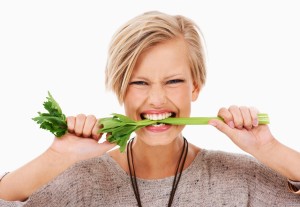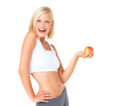3 Ways To Help Yourself Feel Full When on a Diet

Starting a diet is incredibly easy. Every year hundreds of thousands of people make a pledge to start losing weight and for a few weeks or maybe even a month, they stick to that pledge. The difficulty arises in sticking to that pledge for a long enough period of time to actually lose significant amounts of weight. In other words, starting a diet is easy, actually sticking to one is hard.
Dieting shouldn’t mean starving yourself. But trying to feel full when on a diet can be a struggle and this causes many people to give up on their weight loss goals.
Free Report: 15 Foods To Eat Before & After Your Workouts
Choose Foods That Are Healthy And Filing
To feel full when on a diet eat choose fiber-rich foods that are nutritious and within your calorie budget. You should plan out your daily eating based around your calorie budget and choose foods that are healthy and filling.
Then, leave a few hundred calories of room so that you can have small portions of some tasty snacks and treats that will help stop you from feeling deprived or sad. That’s the key to a successful diet.
1. Know How Much You Need To Eat
Be very deliberate about your calorie budget and planning things out during the day. Track everything to ensure you stay within it.
2. Dedicate 90% of Your Calories To Filling Foods
This means fiber-rich and nutrient-dense foods that are good for you. About 90% of your daily calories should come from these foods.
3. Let Yourself Enjoy The Other 10%
While you should find ways to enjoy healthy foods too, roughly 10% of your daily calories can be for portion controlled bites of tasty, yet probably not healthy, foods. If you eat 1,200 calories a day, that means about 120 calories can be towards bite-sized tastes.
Focus on Nutrient-Dense Foods
Nutrient-dense foods are those foods that pack a lot of nutrition into each calorie. Unlike sugary foods and junk foods that have very few nutrients but contain a lot of calories, nutrient-dense foods have lots of nutrients and relatively fewer calories. Examples of nutrient-dense foods include:
- Vegetables such as avocados, spinach, tomatoes and kale
- Whole grains like brown rice, whole wheat, oats and millet
- Nuts and seeds including almonds, pumpkin seeds, sunflower seeds, and walnuts
- Fruits such as pineapples, strawberries, apples, oranges and bananas
Keep Feeling Full
To help you feel full when on a diet you just have to get the majority of your calories from healthy, nutrient-dense foods that are going to fill you up. Then, use portion control and have a few bites of some tasty foods during the day that you’re craving. You won’t be filing up on this unhealthy tasty food because you’re already satiated by other foods. But, you’ll still get to taste test whatever’s good on the menu.
This is by far one of the best ways to keep yourself satisfied while still feeling full and you can actually continue to enjoy many of the things you love so long as you practice portion control.
Avoid Empty Calories
The term “empty calories” refers to foods that are the opposite of nutrient-dense ones. In other words, nutrient-dense foods have more nutrition per calorie than junk foods.
When trying to lose weight, many people stick to their calorie budget but they don’t feel full because they are just eating and drinking empty calories. They continue to eat the foods they like, which aren’t necessarily healthy, and they eat their entire daily calorie budget based on these high calorie, low nutrient foods.
For example, colas and bottled teas can contain a lot of calories – depending on the drink, a 16-ounce can contains anywhere from 150 to 250 calories. And because you don’t feel satisfied after drinking them, they’re “empty” calories. Despite eating or drinking tasty things, when you don’t eat nutritious or filling foods, you end up feeling like you’re starving yourself.
The Foods To Eat Before & After Your Workouts
Some foods play an important role not only as a source of energy for your body but also for your health and should be factored in as part of your daily requirement. Your body also needs a certain kind of nutrition in each stage of an exercise workout. To help you learn what you’re eating is the most effective for your exercise session, download this free report 15 Foods To Eat Before & After Your Workout and see which foods are best at both and after exercise.


Pingback: 9 Weight Loss Rules To Live By - How To Get Flat Abs Fast
Pingback: How Eating Viscous Fiber Can Help Reduce Belly Fat
Pingback: How To Stop Using Food As A Reward - How To Get Flat Abs Fast
Pingback: How Can Food Affect The Brain? - How To Get Flat Abs Fast
Pingback: 5 Key Reasons To Start A Whole Food Diet - How To Get Flat Abs Fast
Pingback: 10 Best Foods For Weight Loss And Why - How To Get Flat Abs Fast
Pingback: Is Low Calorie Eating Better Than Low Fat? - How To Get Flat Abs Fast
Pingback: How Eat Healthy Without Starving Yourself - How To Get Flat Abs Fast
Pingback: Are Your Portions Making You Fat? - How To Get Flat Abs Fast
Pingback: 10 Great Healthy Snacks For Losing Weight - How To Get Flat Abs Fast
Pingback: How To Start Eating Clean For Weight Loss - How To Get Flat Abs Fast
Pingback: 4 Reasons You Eat Too Much - How To Get Flat Abs Fast
Pingback: What Are The Best Energy Boosting Foods?
Pingback: What Are The Best Foods For A Healthy Lifestyle?
Pingback: How To Add More Fruits And Vegetables To Your Diet
Pingback: Understanding Your Hunger and Fullness Cues - How To Get Flat Abs Fast